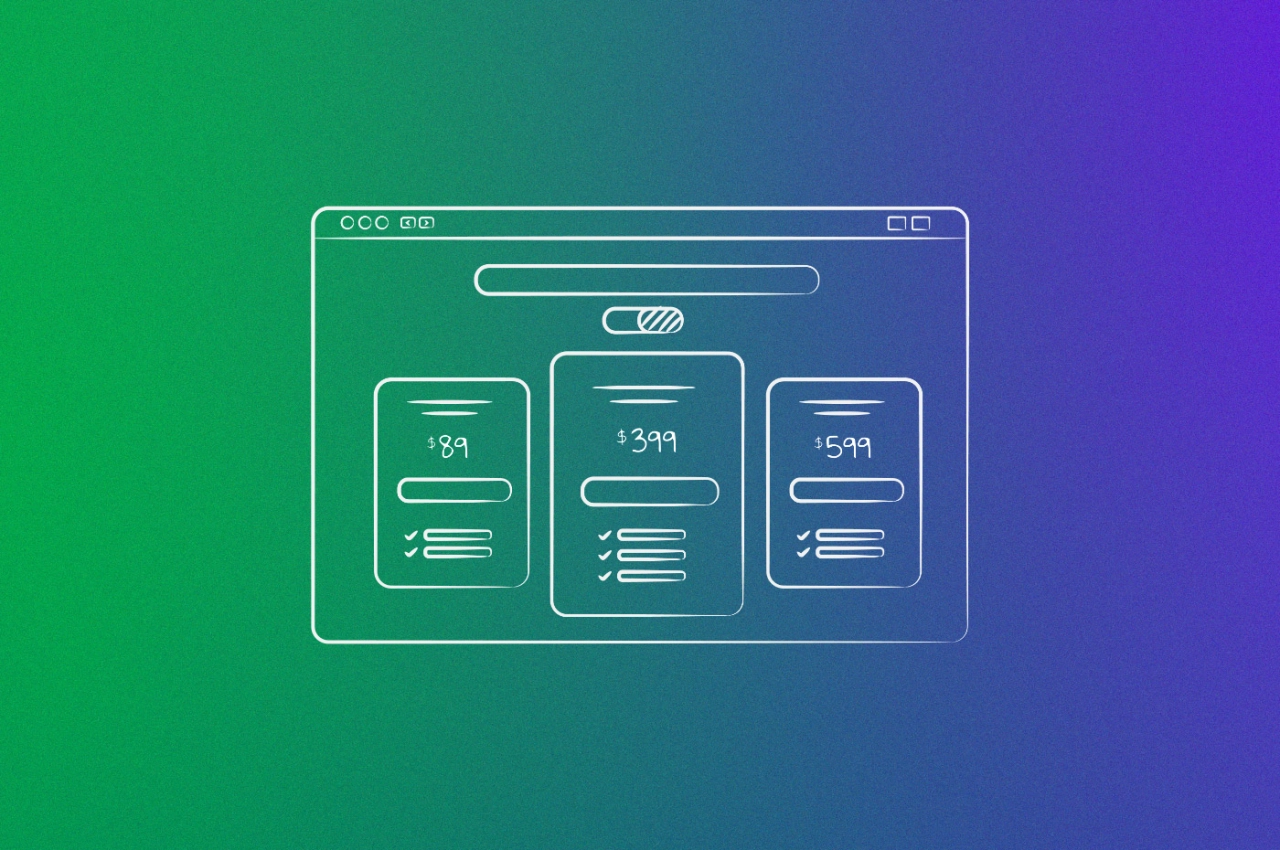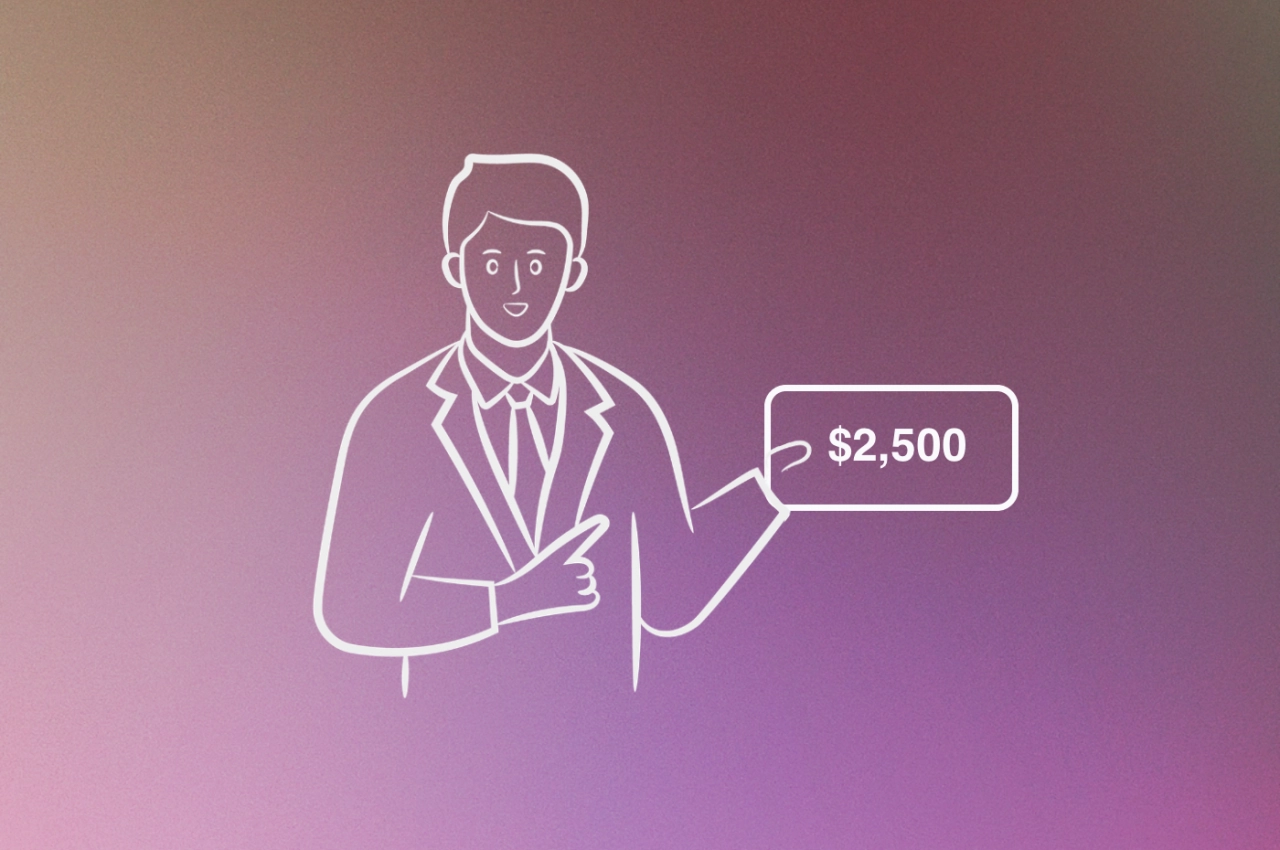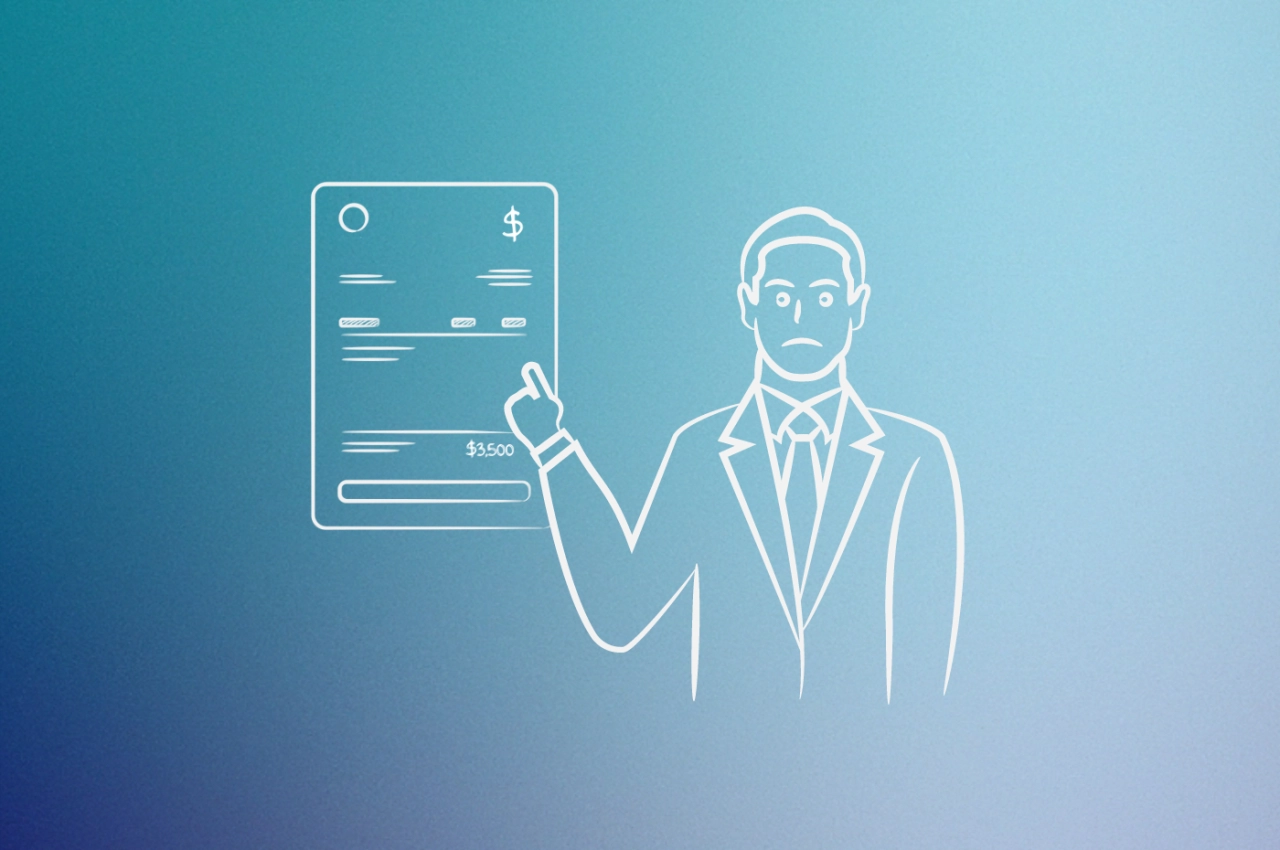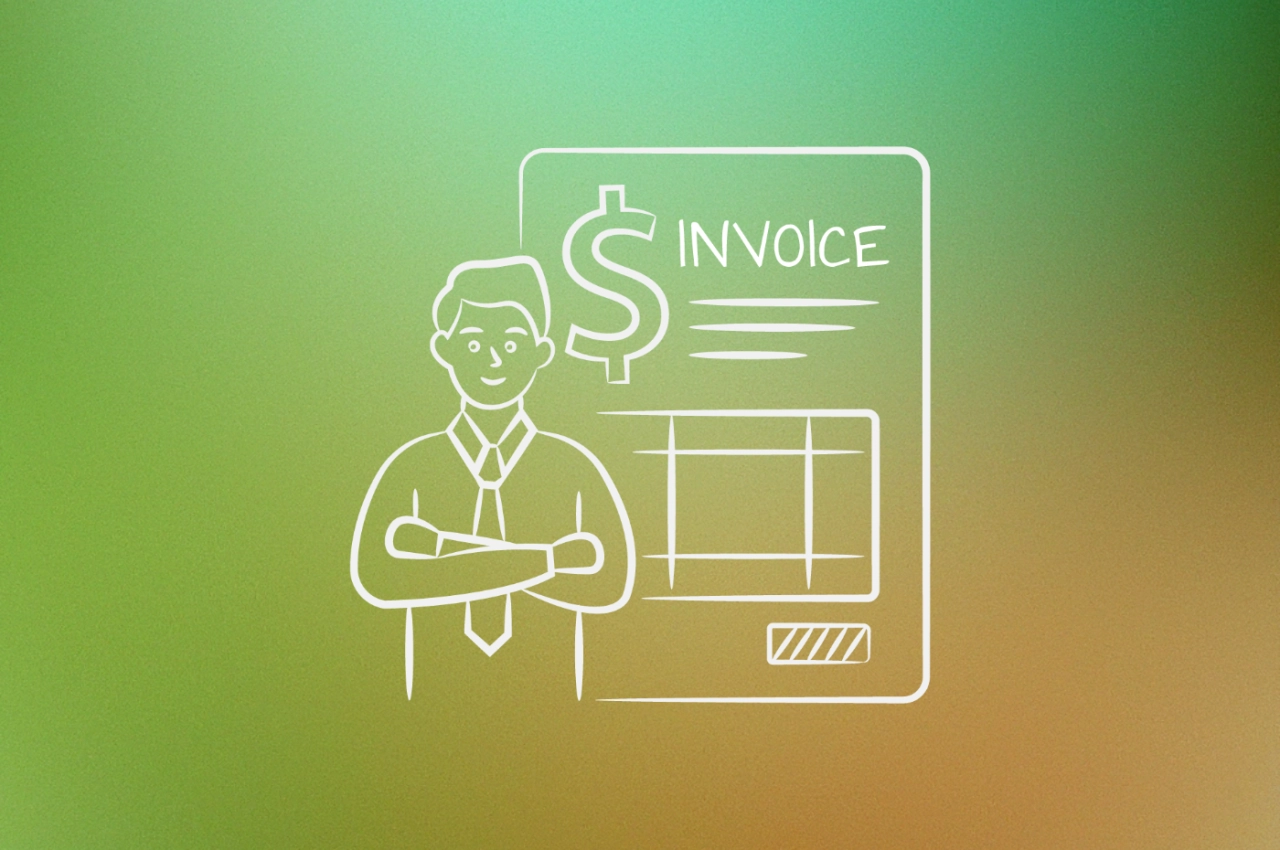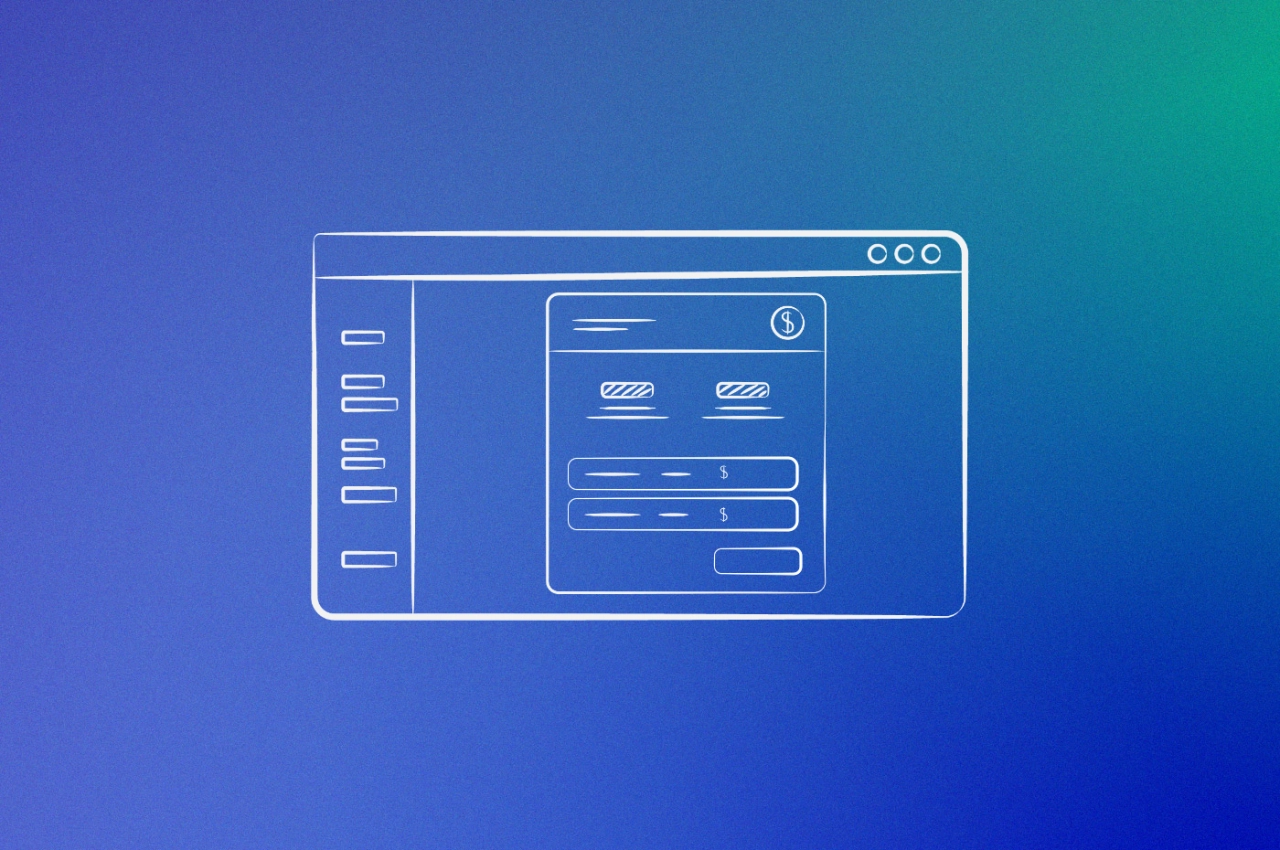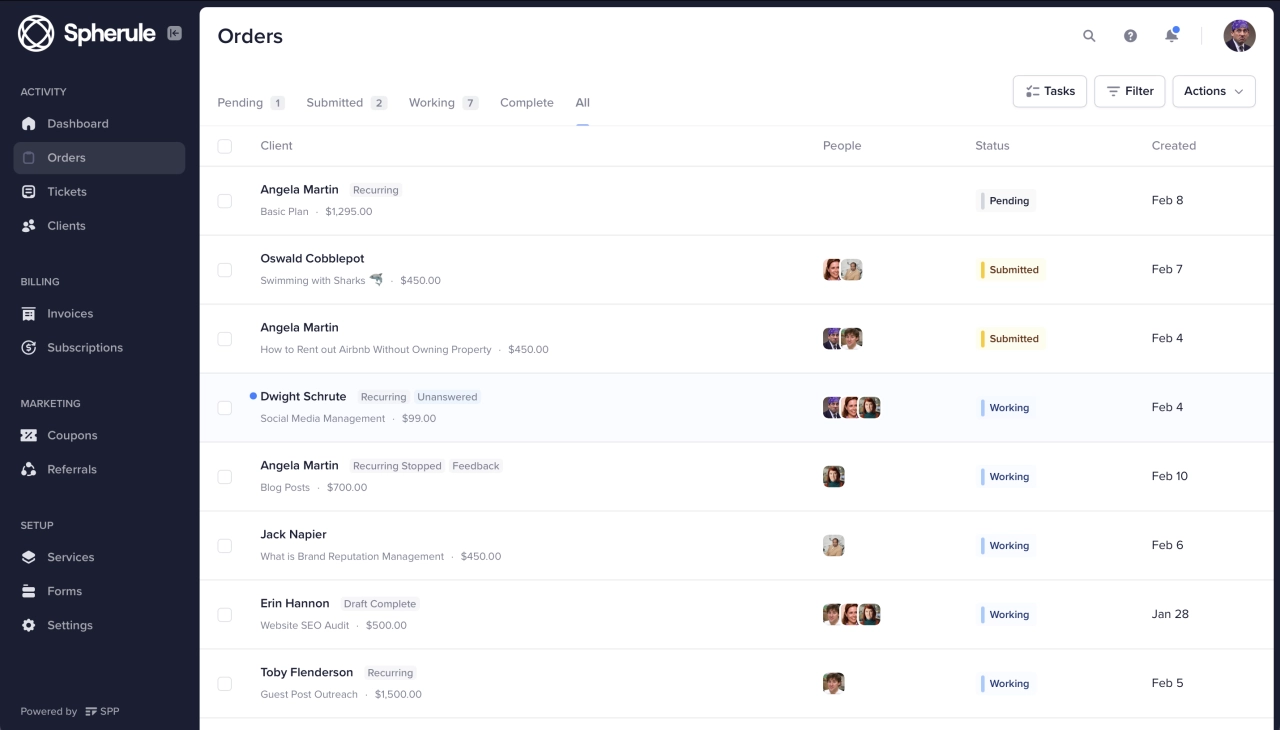- Tiered pricing allows businesses to offer a personalized experience by providing different service levels at different price points, catering to customers' individual needs and preferences.
- Productized services, which are packaged and priced in a way that makes it easy for clients to understand and purchase, can benefit from tiered pricing by standardizing pricing, simplifying the purchase process, and increasing profit margins.
- The benefits of tiered pricing include increased flexibility for customers, easier upselling opportunities for businesses, encouragement of customer loyalty, simplified purchase process, higher profit margins, increased customer lifetime value.
Struggling to find the perfect agency pricing model that attracts new clients without sacrificing profits? Tiered pricing offers marketing agencies a strategic approach that can transform your business economics.
With tiered pricing, you’re not just selling a service—you’re offering clients options that align with their specific needs and budgets. This approach allows your agency to capture more of the market while providing clear upgrade paths that demonstrate additional value.
Let’s look at how structured service tiers can transform your agency’s offerings. By packaging your services at different price points—each with its own set of features and deliverables—you create natural entry points for prospects while maximizing revenue from clients who need comprehensive solutions.
In this article, I’ll break down how to implement tiered pricing in your marketing agency and show you exactly how it can help scale your business.
What is tiered pricing?
Tiered pricing is a popular model for selling services and products within multiple price ranges. Each price offers a different set of services or features. Those who need more features have to opt for one of the higher-priced tiers.
Here’s an example from the agency pricing calculator:

It has generated three tiers, with the one in the middle being ideal. It should be the bext value offer and the one most clients go for.
Tiered pricing is incredibly common in the world of software-as-a-service (SaaS) and other, primarily subscription-based industries, including:
online courses and education
gym memberships
software
cloud storage
website builders
However, this pricing structure can also apply to agencies and organizations in B2B and B2C service industries. This kind of pricing model usually goes hand in hand with a productized business model.
The benefits of tiered pricing
Wondering why so many successful agencies have adopted this model? Here are nine compelling reasons why tiered pricing could be exactly what your business needs to boost revenue, streamline operations, and create better client experiences:
Tiered pricing offers businesses greater flexibility than flat-rate pricing, allowing enterprise-level clients to pay more for additional services while smaller businesses can access services at affordable rates, enabling a wider range of clients to get services at price points they can afford.
The structure makes upselling easier as businesses can offer tiered service levels that encourage customers to supplement orders with add-ons and extras, allowing customers to customize their experience through targeted upsells.
This pricing model encourages customer loyalty by offering rewards for continued patronage, such as loyalty discounts or access to exclusive content and deals.
It simplifies the purchase process by offering different service levels at various price points, making it easier for customers to find options that meet their needs.
Businesses often see higher profit margins than with flat-rate pricing models, as offering various price points capitalizes on larger sections of the demand curve, generating more revenue through greater order volume.
Customer lifetime value typically increases as different service levels encourage repeat business, leading to increased profits over time.
The model helps identify high-value customers by revealing which clients are willing to pay more for premium options, providing better understanding of your most valuable customer segments.
As your business grows, tiered pricing scales effectively by allowing you to add service tiers to accommodate new client segments without increasing costs.
Implementation and maintenance are straightforward compared to project-by-project pricing, requiring only basic client analysis to create targetable segments and determine appropriate services and price points for each group.

Behavioral economics in tiered pricing
Ever wonder why clients consistently choose your middle-tier package? It’s not coincidence—it’s science.
Behavioral economics plays a crucial role in how your pricing tiers influence purchase decisions. Let’s look at two powerful principles you can leverage immediately:
Anchoring creates a reference point that shapes how clients perceive value. By positioning your premium tier first, you anchor clients to a higher price point, making your mid-tier option seem more reasonable by comparison. This is why many agencies lead with their premium offering despite knowing most clients will choose the middle option.
The decoy effect is equally powerful. By strategically designing a third option that makes your preferred tier look like an obvious choice, you’re essentially creating a decoy that drives clients toward your most profitable package. This explains why your Scale package seems irresistible when positioned between Start and Grow options.
These principles help predict how clients will respond to your pricing structure. When clients compare options side-by-side, they don’t evaluate each tier independently—they make relative judgments based on perceived value differences.

With that said, the most effective pricing strategy isn’t just about manipulation—it’s about creating genuine value tiers that align with your clients’ needs while maximizing your agency's profitability.
Common implementation mistakes to avoid
Struggling with your new pricing strategy? While tiered pricing offers significant benefits, I’ve seen many agencies stumble during implementation. Let’s look at the most common pitfalls you should avoid.
Creating too many tiers
One of the biggest mistakes service providers make is overwhelming clients with choices. When faced with too many options, customers often experience decision paralysis—leading to abandoned purchases and lost revenue.
Keep it simple with 3-4 well-defined tiers maximum. This provides enough variety without overwhelming your prospects.
Unclear value differentiation
Your clients shouldn’t need a spreadsheet comparison to understand why one tier costs more than another. Each price jump must clearly communicate additional value.
Make your tier differences obvious by:
Using clear, benefit-focused language for each feature
Highlighting exclusive features in higher tiers
Quantifying differences where possible (e.g., "5 revisions" vs "unlimited revisions")
Over time, we realized that trying to fit SaaS companies into just one or two packages simply doesn’t work. Every company’s growth stage, goals, and internal resources are different. That’s why we created 4 clearly defined, flexible tiers — Breeze, Gale, Tempest, and Hurricane — ranging from €4k/month to €10k+.
 Romana Kuts,
SaaStorm
Romana Kuts,
SaaStorm
Pricing tiers too close together
When your pricing tiers are too similar, you’re not effectively segmenting your market. For example, having tiers at $997, $1097, and $1197 doesn’t create meaningful differentiation.
A good rule of thumb: each tier should be approximately 1.5-2.5x the price of the previous tier. This creates clear separation while maintaining logical progression.
Neglecting your ideal customer profile
Your pricing tiers should align with your target audience segments. I’ve seen agencies design beautiful pricing tables that completely miss the mark because they didn’t consider their actual customer base.
Before finalizing your tiers, ask yourself: "Do these options match the actual needs and budget constraints of my target clients?"
How to develop a tiered pricing model
Now that you know the benefits of the tiered pricing structure, it’s time to set one up. Follow these three steps so to develop the best pricing strategy for your agency.
Step one: think about your target clients
The first step is to think about what kinds of clients your pricing tiers will be built around. This will help you to determine which services you should offer at each price point later on in the process.
To do this, you can segment your customer base by average order value, revenue, location—whatever factors are relevant to your business model. While the specifics will vary from business to business, segmenting ideal customers based on the size of their organization is extremely popular with productized B2B agencies.
Bigger organizations tend to need services in greater quantities than smaller organizations. That makes it easy to create a pricing strategy model that focuses on attracting a wide range of businesses (e.g., solopreneurs, SMEs, enterprise-level companies).
Some want to test the waters with Breeze, others are ready to scale with Tempest or Hurricane. We stay flexible and tailor the solution around real needs — not arbitrary packages. Agencies often overlook that too many tiers or vague options just confuse clients. Instead, let insights lead, and build pricing around real goals.
 Romana Kuts,
SaaStorm
Romana Kuts,
SaaStorm
Step two: look for purchase patterns
The second step is to look for purchase patterns among your segmented client tiers. This will help you to identify which services are most popular with the different segments and how much your clients are willing to pay for them.
To do this, you can analyze your customer data to see which services are most commonly purchased. You can also look at the average order value of your customers to see how much they’re willing to spend.
For example, you might find that the majority of SMEs you work with are only interested in your core service. If that’s the case, you could create a basic tier that’s limited to your core service and additional tiers that include secondary services that will appeal to larger businesses.
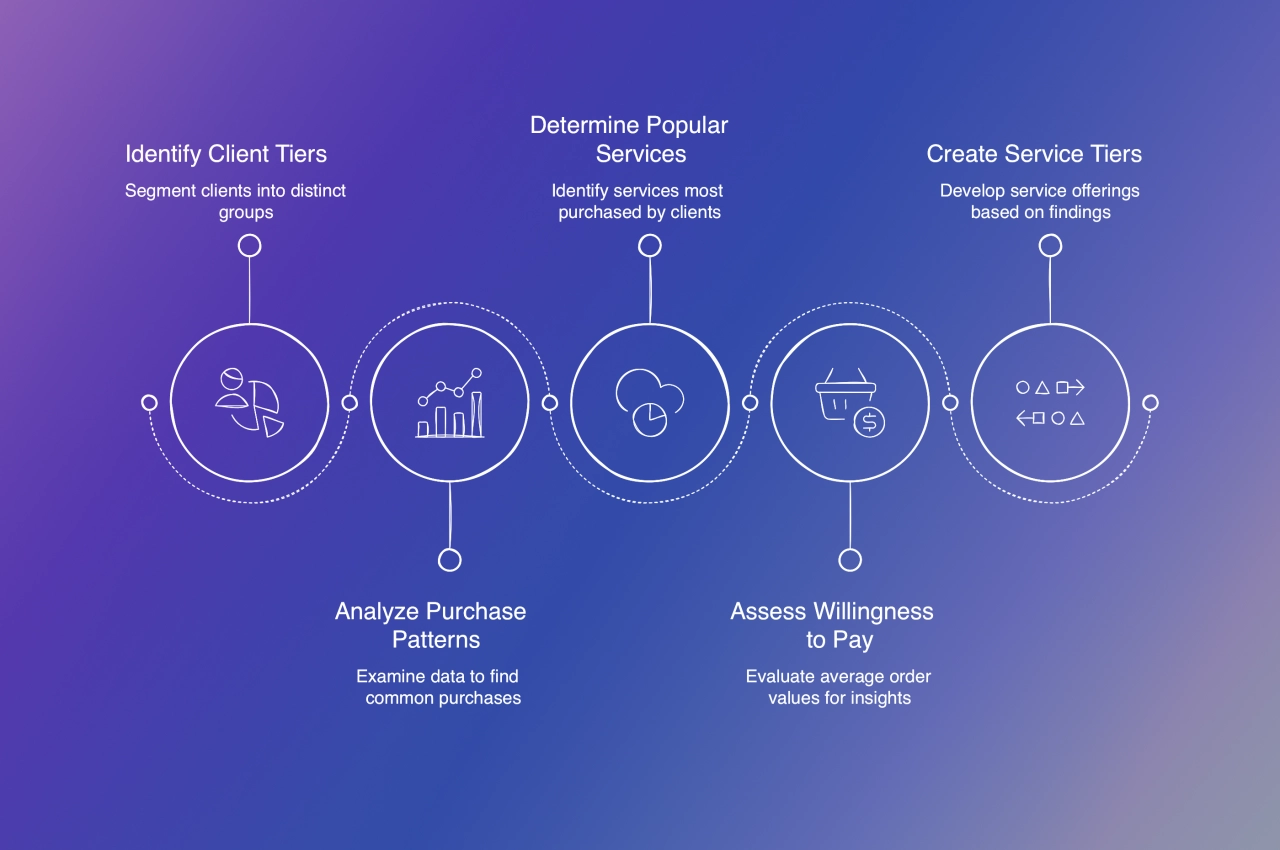
Tip: If you don’t have much customer data to sift through, research the competition! Look at the pricing options of a few well-established agencies in your industry for insight into service offerings that work.
Step three: create your pricing tiers
The third and final step is to create multiple pricing tiers. This step should be pretty simple thanks to the groundwork you’ve already done.
The number of tiers you create should be the same as the customer segments you created in step one. The services you include in each of those tiers will be the services that those segments are most likely to order (i.e., refer to step two).
The only thing left to do is determine an attractive (and sustainable) price for each tier you’ve created. There are a few ways to do this:
Average Order Value: As we mentioned earlier, you can use your customer’s average order value as a guide for how much to charge for each tier. Calculate the average order value of all the clients in a given tier and use the number to come up with a price.
Profit Margin: For a more basic approach, work backwards from the profit margin you’d like each tier to generate. Calculate the total cost of providing the services in a tier (e.g., $100) and determine an ideal profit margin (e.g., 20%). Finally, divide the total cost by one minus the decimal form of your profit margin (e.g., $100 ÷ [1 – 0.2] = $125). The number you get is the price you should charge in order to hit your profit margin goal!
Competitive Analysis: If you’re still not sure how to price your services, take a look at what your competitors are charging. Use their prices as a baseline and adjust accordingly.
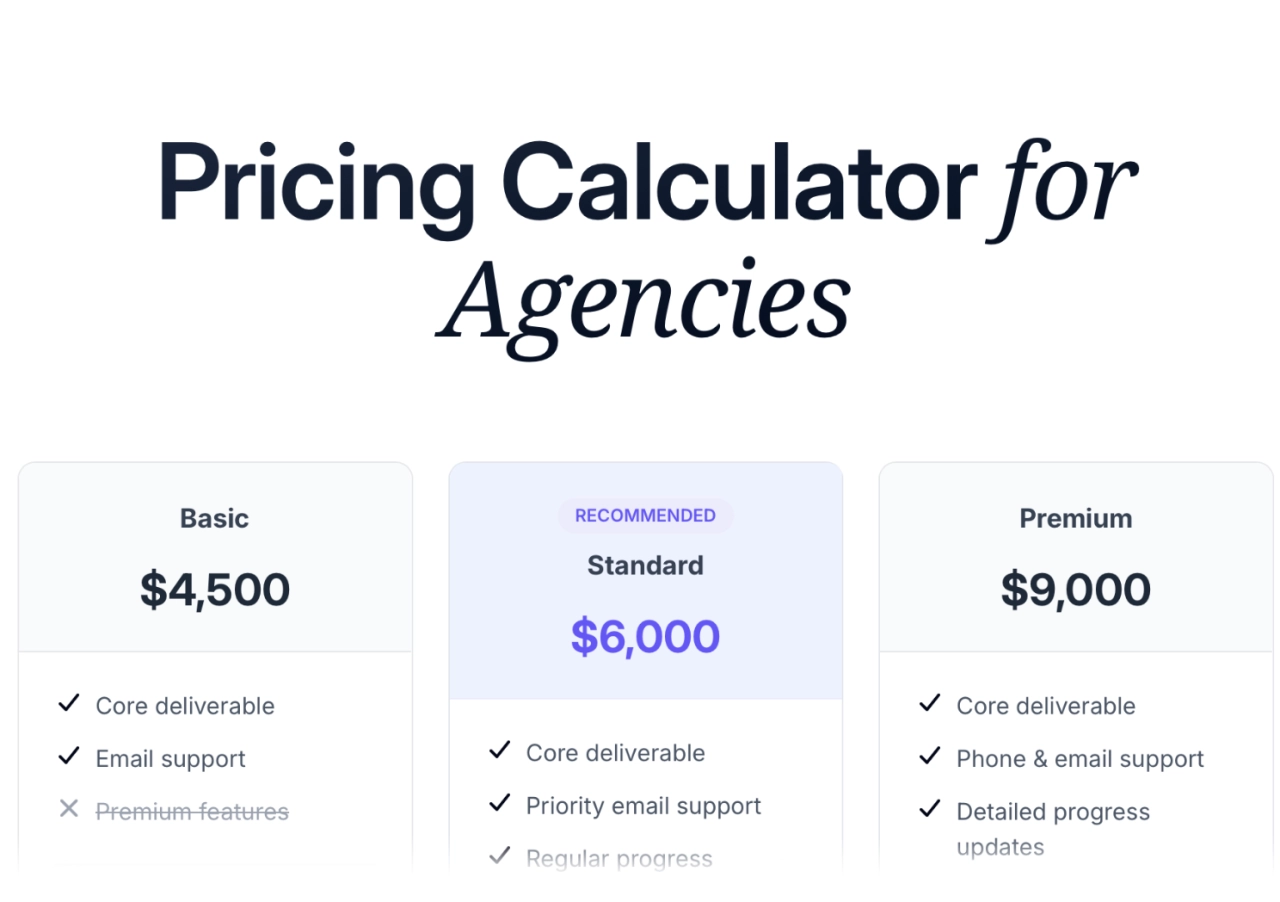
Generate tiered packages for your agency.
If you need help generating your tieres, simply use our handy agency pricing calculator.
Tiered pricing examples
Now that you know more about the tiered pricing structure, let’s look at an example so you can get a better feel for it. Let’s assume you’re a design agency offering recurring services for design tasks. Right now you just have a single plan, but you’ve discovered that it doesn’t satisfy every client. Some need a bit more flexibility and they are happy to pay more for it, while for others it’s too expensive.
You could opt for the classic three-tiered pricing strategy as follows:
Start | Scale | Grow |
|---|---|---|
10 design task/month | 20 design tasks/month | Unlimited tasks/month |
1 task at a time | 2 tasks at a time | 3 tasks at a time |
| dedicated account manager | dedicated account manager |
Usually with tiered pricing, the price anchor is the middle package, which looks like it’s the best deal between the three options. You could highlight it slightly by focusing the design on this one tier.
Tools & resources for implementing tiered pricing
Ready to build your own tiered pricing structure? Here are the essential tools that will make the process smoother and more effective.
Pricing strategy software
Beyond using Service Provider Pro, several specialized tools can help you model and implement tiered pricing:
ProfitWell: Offers pricing optimization tools with customer segmentation
ChartMogul: Provides analytics specifically for subscription businesses
Price Intelligently: Specializes in SaaS pricing strategy but applicable to service businesses
Analytics tools
To properly implement tiered pricing, you’ll need solid data:
Google Analytics: Track how users interact with your pricing pages
Hotjar: Heat maps show where visitors focus on your pricing tables
Mixpanel: User journey analysis reveals which features attract the most interest
Pricing page templates
Don’t reinvent the wheel. Start with proven pricing page layouts:
Webflow templates: Several service business templates include well-designed pricing tables
Elementor templates: WordPress users can find specialized pricing page templates
UI Kits: Design resources like UI8 offer pricing component collections
Tip: The best pricing pages highlight the middle tier, use consistent formatting, and make feature comparisons easy to scan.
With these tools at your disposal, you can create, test, and optimize your tiered pricing structure much more efficiently.
Tiered price FAQ
How is tiered pricing calculated?
The average order value is a good reference point to calculate what customers should pay. You can also use your desired profit margin to price every single tier.
What is an example of tiered pricing?
Most companies use a three-tiered model with a lower, middle and high-priced tier. Three tiers make it easy for users to choose while also giving your company enough variety to serve a wide range of clients.
What is tiered pricing vs flat pricing?
Flat pricing always has the same price for a service/product. For instance, a website will cost the same regardless of how much time needs to be invested into the project delivery.
What are the disadvantages of using tiered pricing?
This method requires you to know how much time you spend delivering services and how to package them into the most popular options. You’ll need to be in business for a while in order to have the data necessary to come up with your tiered pricing strategy.
What is the purpose of tiered pricing?
The purpose of different tiers is to differentiate between your services or product offering while catering to different groups of users. Not everyone needs the full feature set, and some users simply have a lower budget.
How many pricing tiers should I offer?
Most successful service businesses offer 3–5 tiers. Three tiers is the sweet spot—an entry-level option, a middle best value option, and a premium option. Too many tiers create decision paralysis for customers.
When should I consider revising my pricing tiers?
Review your pricing structure quarterly, or when: more than 70% of clients select a single tier, your profit margins decline, your service delivery costs change significantly, or competitors make notable pricing changes.
Can I offer custom pricing alongside tiered pricing?
Yes, many agencies include an Enterprise or Contact Us tier for clients with complex needs. This preserves your tiered structure while accommodating clients who need customization.
How do I transition existing clients to a new tiered pricing model?
Grandfather existing clients at their current rates while offering incentives to switch to your new structure. Provide a 3–6 month notice period and explain the additional value they’ll receive at each tier.
Should I display my pricing publicly on my website?
For standardized services with straightforward deliverables, public pricing increases trust and qualification efficiency. For complex services, using a “Starting at” pricing or requiring contact for detailed quotes often works better.
Closing thoughts
Tiered pricing transforms how service businesses capture value and scale operations. By strategically packaging your services at different price points, you create clear entry paths for prospects while maximizing revenue from clients who need comprehensive solutions.
Remember that successful tiered pricing requires alignment between your service delivery capabilities and client expectations. Start with three well-defined tiers, continuously analyze which options resonate with clients, and adjust both features and pricing as your understanding deepens.
Disclaimer: This article provides general information about pricing strategies for service businesses. While we strive for accuracy, this content should not be considered financial advice. Every business has unique circumstances. We recommend consulting with a qualified financial professional or business advisor before making significant changes to your pricing strategy.
